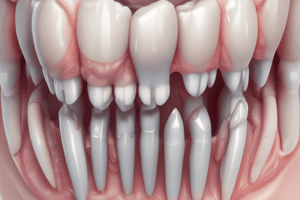Podcast
Questions and Answers
What is defined as the physiological movement of teeth from their developmental position through the soft tissues to their functional position in the oral cavity?
What is defined as the physiological movement of teeth from their developmental position through the soft tissues to their functional position in the oral cavity?
- Tooth eruption (correct)
- Tooth development
- Tooth exfoliation
- Tooth resorption
Which phase of tooth eruption begins during the bell stage and involves the movement of the developing tooth within the alveolar bone?
Which phase of tooth eruption begins during the bell stage and involves the movement of the developing tooth within the alveolar bone?
- Initial eruption phase
- Post-eruptive phase
- Pre-eruptive tooth phase (correct)
- Active eruption phase
During which phase does a tooth move through the alveolar bone and soft tissue until it reaches occlusion?
During which phase does a tooth move through the alveolar bone and soft tissue until it reaches occlusion?
- Post-eruptive phase
- Pre-eruptive tooth phase
- Active eruption phase (correct)
- Resorptive phase
What initiates the process of exfoliation of primary teeth?
What initiates the process of exfoliation of primary teeth?
What forms the reduced enamel epithelium after amelogenesis is completed?
What forms the reduced enamel epithelium after amelogenesis is completed?
Which theory of tooth eruption suggests that the tooth crown is elevated by root development?
Which theory of tooth eruption suggests that the tooth crown is elevated by root development?
What is the role of odontoclasts during the process of tooth exfoliation?
What is the role of odontoclasts during the process of tooth exfoliation?
Which theory related to tooth eruption is characterized by signals between the dental follicle and reduced enamel epithelium?
Which theory related to tooth eruption is characterized by signals between the dental follicle and reduced enamel epithelium?
What process occurs throughout life, even after a tooth has been extracted, to maintain occlusion?
What process occurs throughout life, even after a tooth has been extracted, to maintain occlusion?
Flashcards
Tooth Eruption
Tooth Eruption
The process where teeth move from their developmental position in the alveolar bone through the soft tissues to their functional position in the mouth.
Tooth Exfoliation
Tooth Exfoliation
The physiological resorption of primary teeth until they are lost, typically starting before birth and continuing throughout life.
Pre-Eruptive Phase
Pre-Eruptive Phase
The phase during which the developing tooth remodels the bony crypt in the alveolar bone to accommodate its growth, starting during the bell stage.
Active Eruptive Phase
Active Eruptive Phase
Signup and view all the flashcards
Post-Eruptive Phase
Post-Eruptive Phase
Signup and view all the flashcards
Dento-Gingival Junction
Dento-Gingival Junction
Signup and view all the flashcards
Root Formation Theory
Root Formation Theory
Signup and view all the flashcards
Bone Remodelling Theory
Bone Remodelling Theory
Signup and view all the flashcards
Dental Follicle Theory
Dental Follicle Theory
Signup and view all the flashcards
Periodontal Ligament Theory
Periodontal Ligament Theory
Signup and view all the flashcards
Study Notes
Tooth Eruption and Exfoliation
- Eruption: The physiological movement of teeth from their developing position to their functional position in the mouth. It's a continuous process throughout life.
- Exfoliation: The physiological resorption and loss of primary teeth, also a continuous process.
Phases of Tooth Eruption
- Pre-eruptive: Movement of the developing tooth within the jawbone (alveolar bone). This stage starts during the bell stage of tooth development, and involves reshaping the bone crypt to accommodate the growing tooth. This is the movement of the developing tooth inside the bone crypt.
- Active Eruption: The tooth moves through the bone and the soft tissue until it reaches its final occlusal position. This stage occurs roughly simultaneously with root formation.
- Post-eruptive: Ongoing movement of the tooth to maintain a functional bite and compensate for wear and growth throughout life.
Dento-gingival Junction Origin
- The structure forms from the reduced enamel epithelium.
- As amelogenesis (enamel formation) finishes, the ameloblasts reduce in size and fuse with elements of the outer enamel epithelium, stratum intermedium, and remaining stellate reticulum to create the reduced enamel epithelium.
- This structure shields the developing tooth crown, merges with the oral mucosa (forms the pathway for eruption), and forms the dento-gingival junction, preventing the oral cavity from getting into the body.
Tooth Exfoliation
- Successor eruption: Development and eruption of permanent teeth that replace primary teeth initiates their resorption.
- Resorption: Odontoclasts resorb the roots of primary teeth, progressing towards the crown. This happens gradually.
- Masticatory forces: These forces facilitate primary tooth exfoliation, albeit their role is indirect.
Theories of Tooth Eruption
- Root Formation Theory: The growing root pushes the crown toward the gumline.
- Bone Remodelling Theory: The exact cause of bone resorption is uncertain if it is a cause of or effect from signalling. Dental follicle plays a role in modulating bone changes, not osteoclasts.
- Dental Follicle Theory: Interaction between dental follicle and the reduced enamel epithelium is implicated in bone remodelling and eruption.
- Periodontal Ligament Theory: The supporting ligaments formed by fibroblasts, contribute to the movement during eruption.
Studying That Suits You
Use AI to generate personalized quizzes and flashcards to suit your learning preferences.



